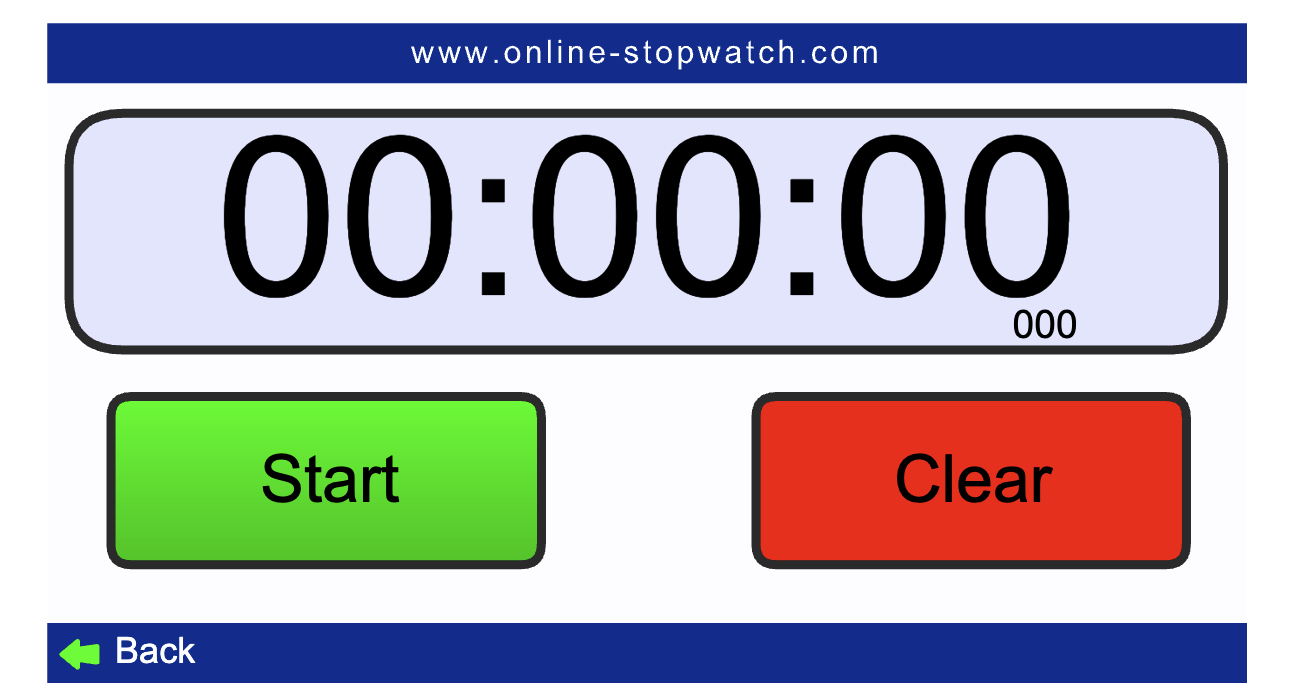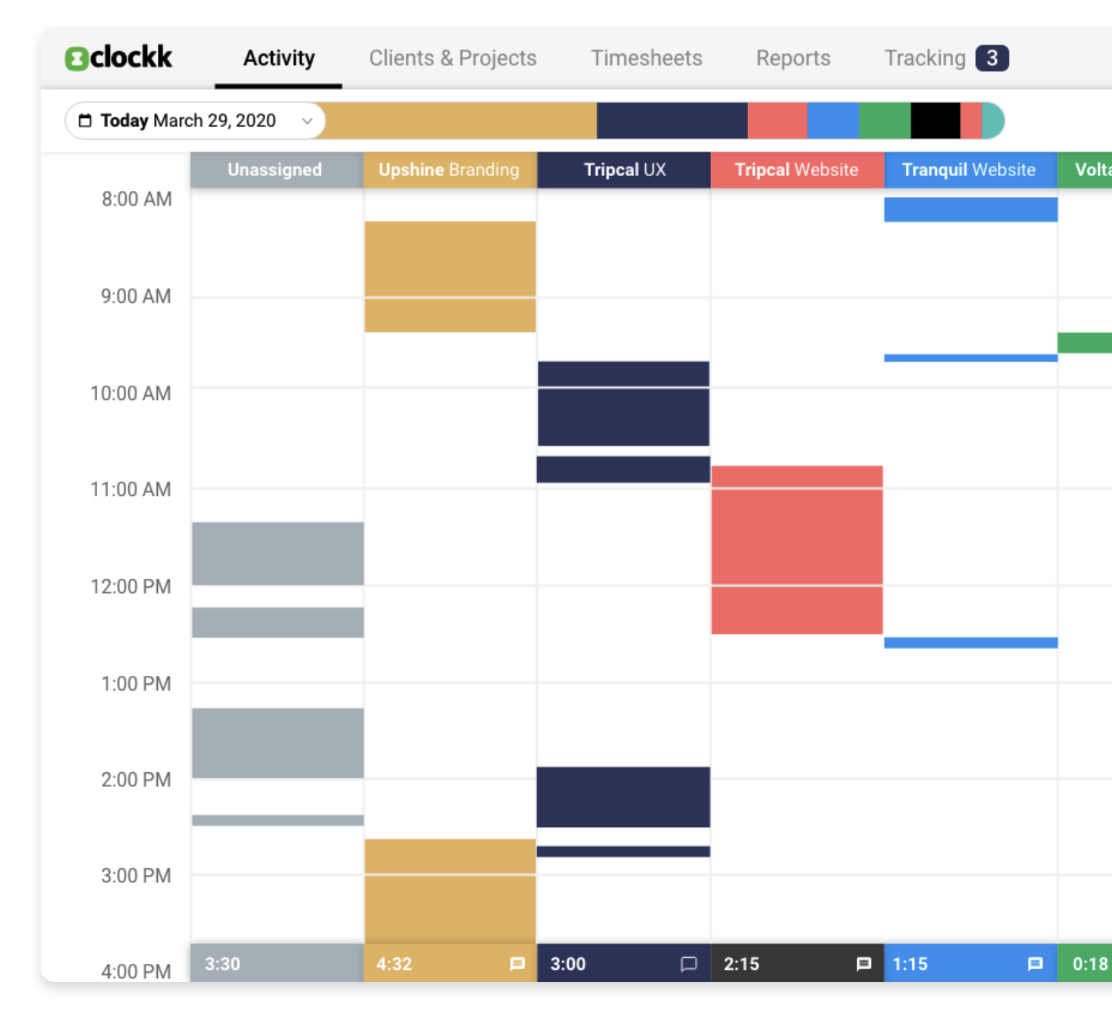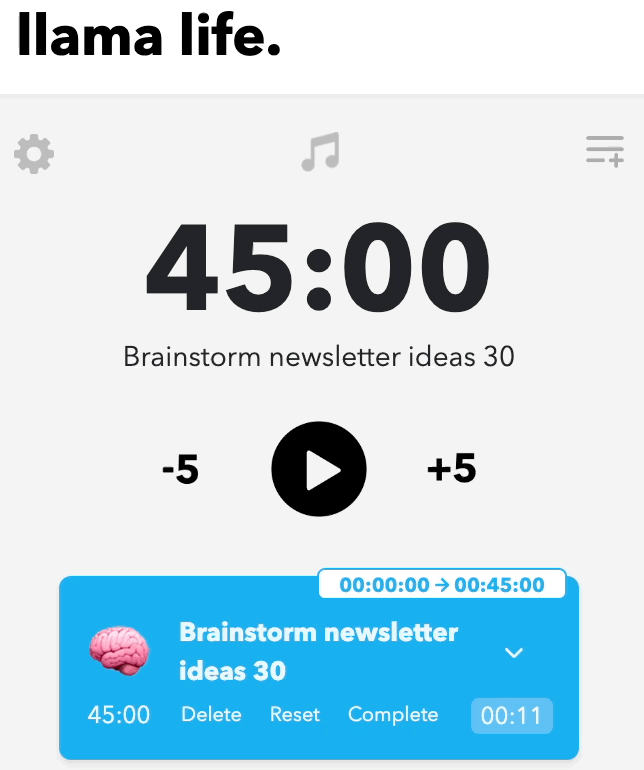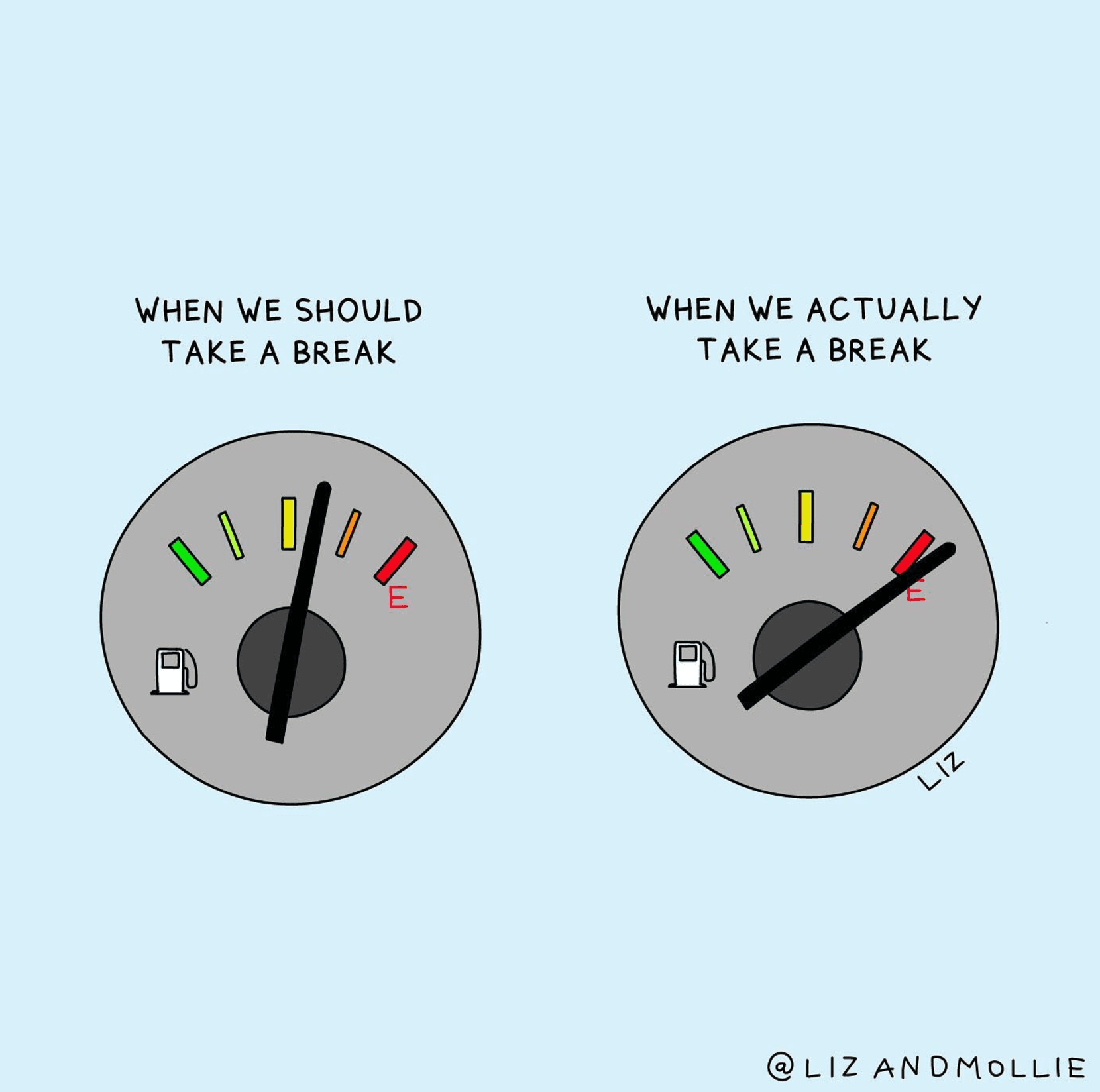If you're looking for a simple task timer that can boost your productivity, you'll most likely run into one of these two problems:
1. Either the task timers are too simple, and for some reason look like they were designed and built in the 90s?
or...
2. They are overloaded with features that you don't need, like tracking billable hours, invoicing, and budgeting, because they are designed for freelancers and agencies.
If you're looking for one of these feature robust tools that are designed for tracking billable hours, check out Clockk, Toggl or Harvest.
Image: Clockk
Or, if you are looking for a productivity tool that lets you time block tasks on your calendar, you can check out Sunsuma, or Akiflow.
However, if you're looking for a simple, well-designed task timer that you can use to boost your productivity, my friend, you are in the right place.
What is a task timer and why should I use one?
First, let's get on the same page. What is a task timer?
A task timer is a physical or digital tool to help you measure and visually see how much time you spent on a task. Think of it like a stopwatch, but for your work activities. And it can be used for multiple purposes and all types of tasks.
Many freelancers and contractors that bill clients for their time use a task timer to record how many hours are spent on that client's project, allowing them to keep track of billable hours and ensure they are getting paid for every minute of work.
Others use task timers simply as a personal productivity and time management tool. For instance, some use task timers to create a sense of urgency for themselves and stay focused on a task.
Task timers are also popular as a tool to improve one's awareness of the concept of time. And they've recently become popular as a tool to help people with ADHD to stay focused, especially those who deal with time blindness, and need a special approach for task and time management.
Using task timers for personal productivity and time management
As we mentioned, one of the main use cases for task timers is for personal productivity and time management. That's because task timers can help you in many ways:
- Staying focused: Setting a timer for a task and having it visual while you work on it can remind you what you're suppose to be doing and help you stay focused.
- Preventing procrastination: Another major benefit of task timers is that they can help prevent procrastination. When we know we have a limited amount of time to complete a task (creating a positive time constraint), we're more likely to dive in and get started right away, rather than putting it off for later
- Understanding project completion time: Using a task timer also helps you understand how long you're spending on each of your projects. By tracking your time, you can identify which tasks take longer than you thought, and adjust your schedule accordingly.
- Combat time blindness: A task timer is especially helpful for those who struggle with time blindness associated with ADHD by helping them think through how long something will take and getting better at their estimations over time.
- Healthy regular breaks: When a timer goes off, it can be a good reminder to take a break before starting the next one. Research shows taking short, frequent breaks throughout the day can actually boost your productivity. People often use task timers to schedule and time their breaks, ensuring that they don't get too caught up in their work and forget to take a breather.
- Overcoming decision fatigue: When we have too many choices to make throughout the day, it can wear down our ability to make good decisions. By using a timer to help structure your day, you're making fewer decisions and conserving your mental energy for the important stuff.
- Prevent external interruptions: By designating specific blocks of time for focused work, you can let others know that you're not to be disturbed during those periods. This can help prevent interruptions.
One of the most popular and common examples of using timers for productivity is the Pomodoro method.
The Pomodoro Technique: what it is and why it works
Simply put, the Pomodoro Technique is a time management method where the idea is to work on a specific task (called a Pomodoro) for 25 minutes straight, without any distractions, and then take a short 5 minute break before starting the next Pomodoro.
After completing four Pomodoros, you take a longer break of 15–30 minutes. This method has been shown to increase focus and productivity, while also preventing burnout.
But why 25 minutes? Is there any science behind this seemingly arbitrary time limit?
The answer is a resounding yes!
Here's why:
The Pomodoro Technique is based on the idea that the brain can only focus effectively for a certain amount of time before it needs a break.
According to research, the average attention span for most people is around 20–30 minutes. That's why the Pomodoro Technique recommends 25 minute work intervals, followed by a 5 minute break.
Additionally, studies have shown that taking short breaks actually leads to better productivity and creativity in the long run.
When you take a break, your brain has a chance to process and consolidate the information you've just learned, leading to better retention and recall.
That's why the Pomodoro Technique is so powerful, it is designed for optimal brain function. It's also an easy and straightforward framework to follow.
The best Pomodoro timer for daily tasks
If you're looking for a way to use the Pomodoro Technique in your work, then a Pomodoro timer might just be the perfect tool for you.
One of the best Pomodoro timers that we can find is Pomofocus. This timer is simple and easy to use, with a clean and minimalistic interface that won't distract you from your work.
Why we like it:
- ability to estimate how many Pomodoros a task will take you, allowing you to track tasks longer than 25 minutes
- has both long and short break times built in, which can help you to recharge and refocus between work intervals.
- can connect to Todoist and import all of your Todoist tasks into Pomofocus within a few quick clicks.
What could be improved:
- The timer takes up the full screen, which can make it difficult to see while you're working.
- The timer only allows for 25 minute focus periods, which some users may find restrictive. It may not be enough for certain tasks, or too long for smaller tasks.
- The design leaves something to be desired
Who its great for:
Someone who doesn't need any customization or features
Pricing:
Free with premium options
Why Pomodoro timers don't work for everyone
While Pomodoro timers work wonders for some, they may not work for everyone. Here are a few reasons why:
- Rigid and repetitive nature: Having to stick to the same time intervals and take the same breaks every day can be boring and monotonous, which can lead to a lack of motivation.
- Not well-designed: While some users may be fine with this, others may prefer more customizable options and features. For instance, Llama Life offers custom timers per task, allowing you to select the time, emoji, and color that best suits your specific task.
- Timers are not associated with specific tasks: This lack of organization can be frustrating for those with ADHD, who may have trouble remembering what they were supposed to be doing once the timer goes off.
- Pomodoro apps are usually pretty bare bones: These tools are typically free, so they aren't usually very well designed. Many feel robotic and aren't fun to use.
If you really want to boost your productivity, or you struggle with ADHD, you're probably going to want more than a simple Pomodoro timer. You may want something that also helps you organize your tasks, that is well-designed, and fun to use.
That's why I love a task timer that also function as a to-do list, such as Llama Life.
The best task timer for productivity with a beautiful and intuitive interface
If you're looking for a task timer that's simple, fun and effective, Llama Life is the one for you.
What we like about it:
- Also functions as a task list / to-do list
- Custom countdown timers for each individual task
- Helpful key features: like brown noise to keep you focused and a visual pie timer, without overloading the product experience
- Simple design features: the cute llama mascot (Lulu!) adds a fun and playful touch that can make your timer experience a little more enjoyable.
- customizable settings
- keyboard shortcuts
- Serves as a customizable pomodoro timer
What could be improved:
- There is no calendar view in Llama Life, so if you are looking for a time blocking tool (rather than a task timer) this may not be for you
Who its best for:
- People who want a simple and fun tool without a calendar feature
- People with ADHD who struggle with time blindness
- People who want to customize their experience to their preferences
Pricing:
- 7 day free trial
- $39 Annual plan
- $6 Monthly Plan
Physical task timers vs digital task timers
When it comes to task timers, many people opt for physical timers, and it's not hard to see why. They're simple, easy to use, and provide a tactile experience that can make tracking time feel more concrete.
Something as simple as a kitchen timer, egg timer or a Time Timer.
However, there are some downsides to physical task timers that you should be aware of before making a purchase.
First and foremost, physical task timers lack the digital record-keeping capabilities of their digital counterparts.
With no way to track how long each task takes, you'll have to rely on your memory or jot down notes manually, which can be a hassle.
Additionally, physical timers offer no way to estimate an end time, which can be a problem if you're working on a tight schedule.
Another downside of physical timers is their size and portability. Many physical task timers are bulky and hard to carry around, which can be an issue if you need to take your timer with you on the go.
This can be especially problematic for people who travel frequently, as carrying around a bulky timer can be a hassle.
However, some unique online task timers do a pretty decent job of acting as a physical task timer and provide additional benefits beyond simply tracking time.
For example, Llama Life allows you to enter individual tasks for each timer, essentially serving as an ADHD to-do list. This can be helpful for people who struggle with executive function and need additional support in managing their tasks.
How to use a task timer for productivity?
Using a productivity timer can be a game-changer for your productivity levels.
Not only does it help you stay on track and focused on the task at hand, but it also ensures that you make the most of your time.
So, how do you use a productivity timer effectively? Here's a step-by-step guide:
Step 1: Decide what goals or tasks you will work on
The first step to using a productivity timer is to decide on the task or goal you want to work on. It's important to choose a task that's specific and actionable. For example, instead of writing 'work on a project,' your goal may be to 'write the first draft of a project proposal.'
Step 2: Break that task into smaller actionable chunks
Breaking down your goal into smaller tasks will help it be more achievable, and less overwhelming. For example, 'conduct research' or 'map out the main points for proposal'.
Step 3: Estimate how long it will take
Once you've decided on the tasks, estimate how long it will take you to complete them. Be realistic and don't underestimate the time it will take. If you're not sure, it's better to overestimate than underestimate.
Step 4: Enter the task and the time in your task timer or productivity tool
Next, enter the task and the estimated time in your task timer or productivity tool. This ensures that you have a clear goal and a specific timeframe to work within.
Step 5: Start the timer and start the task
Once you've entered the task and time, start the timer, and start working on the task. It's essential to stay focused and avoid distractions during this time.
Step 6: Once the timer is up, take a break
When the timer goes off, take a break. This break allows you to recharge and refresh your mind.
If you haven't completed the task within the estimated time, repeat the steps until it's completed. Adjust the estimated time and set a new timer based on how much time you think is left.
Final verdict
In conclusion, task timers don't have to suck. In fact, they can be a game-changer for your productivity and focus if they are simple and easy to use.
Whether you struggle with staying focused due to ADHD, or are just looking for that extra edge, a task timer can help you stay on track, avoid distractions, and get more done in less time.
But here's the thing: using a task timer is not a magic bullet.
It won't solve all your problems or make you an overnight success.
It's just a tool, and like any tool, it's only as effective as the person using it.
So, if you're serious about taking control of your time and achieving your goals, then it's time to put that task timer to work.
Experiment with different methods, find what works for you, and don't be afraid to make adjustments along the way. Remember, productivity is not about doing more, it's about doing what matters.
Written by: Dhruvir Zalar
I aim to write blog posts that help ADHD warriors by simplifying complex topics and distilling them in the form of actionable and data-driven articles. When I'm not writing or editing, you can find me reading books (mostly non-fiction) or playing table tennis (badly).










